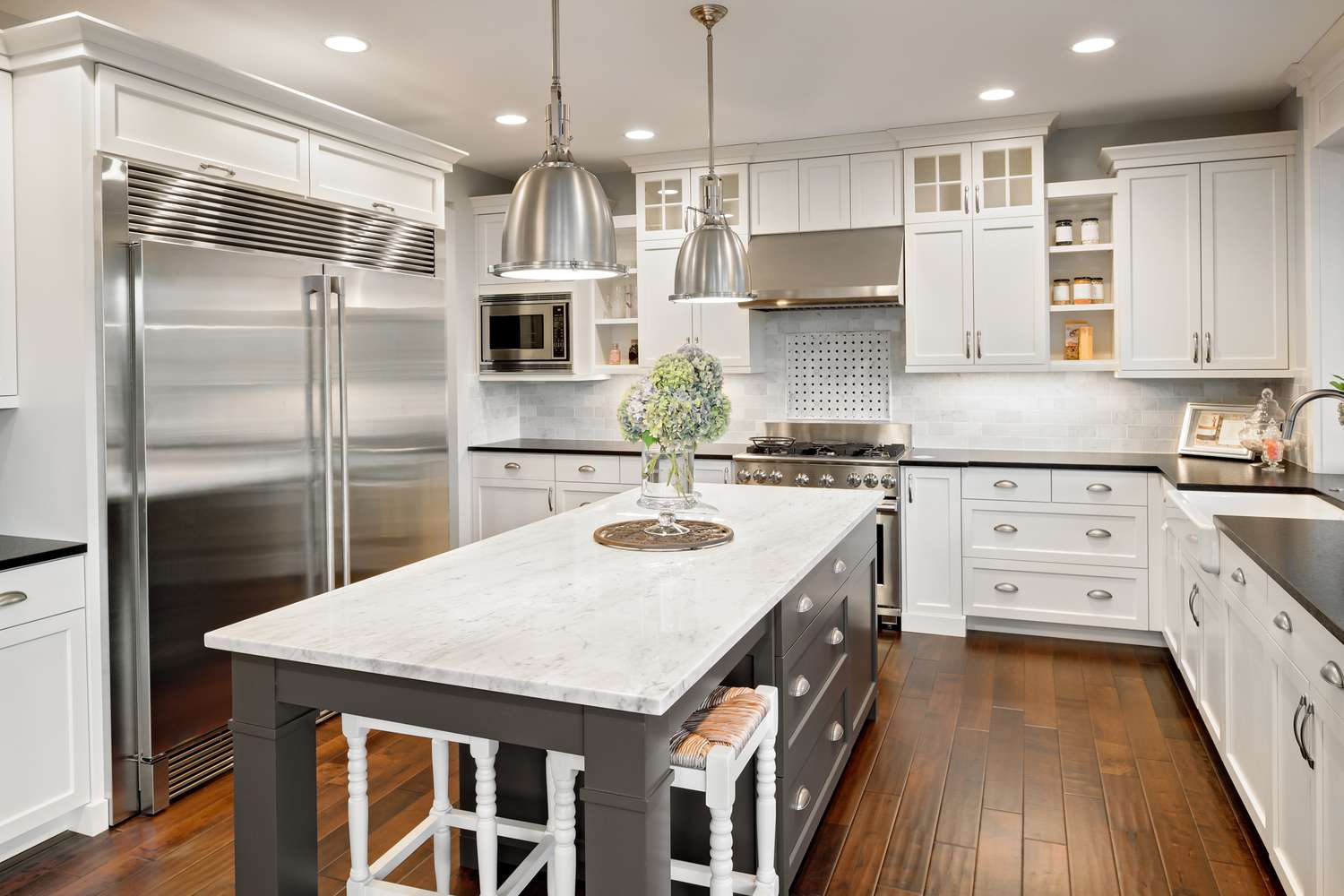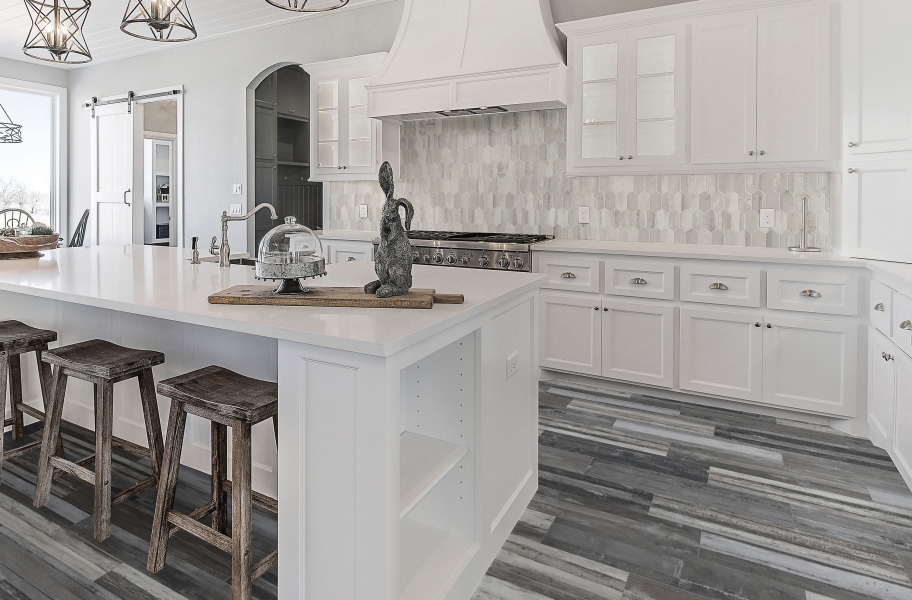Kitchen flooring options, choosing the right kitchen flooring is a crucial decision that can significantly impact the overall look, feel, and functionality of your space. With a wide range of materials, styles, and finishes available, selecting the perfect flooring option for your kitchen requires careful consideration of factors such as durability, maintenance, aesthetics, comfort, and budget. In this comprehensive guide, we will explore the various kitchen flooring options, their pros and cons, and key considerations to help you make an informed decision that suits your lifestyle and design preferences.

Selecting the Perfect Kitchen Flooring: A Comprehensive Guide
Introduction
The kitchen is one of the most heavily trafficked areas in the home, making the choice of flooring a critical decision that can affect both the aesthetic appeal and practicality of the space. From hardwood and tile to laminate and vinyl, there are numerous flooring options available, each with its own unique characteristics and benefits. In this guide, we will delve into the different types of kitchen flooring options, highlighting their features, advantages, and considerations to help you choose the best option for your needs.
Section 1: Types of Kitchen Flooring Options
-
Hardwood Flooring:
- Pros: Timeless beauty, warmth, durability, and resale value.
- Cons: Susceptible to water damage, scratches, and stains without proper maintenance.
- Considerations: Engineered hardwood or hardwood with a protective finish is suitable for kitchens. Regular sealing and maintenance are essential to prevent damage from moisture and spills.
-
Tile Flooring:
- Pros: Variety of styles, colors, and patterns, water-resistant, durable, and easy to clean.
- Cons: Cold and hard underfoot, grout lines require maintenance, can be slippery when wet.
- Considerations: Porcelain or ceramic tiles are popular choices for kitchen floors. Opt for textured tiles for better slip resistance and choose darker grout colors to hide dirt and stains.
-
Laminate Flooring:
- Pros: Affordable, easy to install, durable, and low maintenance.
- Cons: Prone to water damage, cannot be refinished, may not add value to the home.
- Considerations: Look for laminate flooring with water-resistant properties for kitchen use. Select high-quality laminate with a thick wear layer for better durability and longevity.

-
Vinyl Flooring:
- Pros: Water-resistant, comfortable underfoot, durable, and available in a wide range of styles.
- Cons: Prone to scratches, may require periodic sealing, can emit volatile organic compounds (VOCs).
- Considerations: Choose luxury vinyl plank or tile flooring for a realistic wood or stone look. Opt for waterproof vinyl with a protective top layer for enhanced durability and stain resistance.
-
Stone Flooring:
- Pros: Natural beauty, durability, heat resistance, and high-end appeal.
- Cons: Expensive, requires regular sealing, cold underfoot, heavy and difficult to install.
- Considerations: Popular stone options for kitchen flooring include granite, marble, limestone, and slate. Use area rugs or mats in high-traffic areas to add warmth and comfort.
-
Cork Flooring:
- Pros: Sustainable, comfortable underfoot, sound-absorbing, and environmentally friendly.
- Cons: Prone to dents and scratches, requires sealing, can fade in sunlight.
- Considerations: Cork flooring is a resilient and eco-friendly option for kitchens. Apply a polyurethane finish for added protection against moisture and wear.
Section 2: Key Considerations in Choosing Kitchen Flooring

- Durability: Select a flooring material that can withstand the rigors of daily kitchen activities, including spills, foot traffic, and dropped items. Consider the durability of the material, its resistance to scratches, stains, and moisture, and its long-term performance in a high-traffic environment.
- Maintenance: Evaluate the maintenance requirements of different flooring options and choose one that fits your lifestyle and cleaning habits. Some materials may require regular sealing, refinishing, or specialized cleaning products, while others offer easy maintenance and stain resistance.
- Aesthetics: Consider the style, color, and texture of the flooring in relation to your kitchen design and overall decor scheme. Opt for a flooring option that complements the cabinetry, countertops, and other elements in the space while reflecting your personal taste and aesthetic preferences.
- Comfort: Take into account the comfort and ergonomics of the flooring material, especially if you spend long hours standing or cooking in the kitchen. Select a flooring option that provides cushioning, warmth, and sound absorption to enhance comfort and reduce fatigue.
- Budget: Set a realistic budget for your kitchen flooring project and explore options that offer the best value in terms of cost, quality, and durability. Compare prices, installation costs, and long-term maintenance expenses to find a flooring option that meets your financial constraints.
Section 3: Popular Kitchen Flooring Trends
- Wood-Look Flooring: Luxury vinyl planks and laminate flooring that mimic the look of real wood are popular choices for modern kitchens, offering the warmth and beauty of hardwood with added durability and ease of maintenance.
- Patterned Tiles: Intricate patterns, geometric designs, and bold colors in porcelain or cement tiles are trending in kitchen flooring, adding personality and visual interest to the space.
- Large Format Tiles: Oversized tiles in porcelain or ceramic create a seamless and contemporary look in kitchens, minimizing grout lines and enhancing the sense of spaciousness.
- Mixed Materials: Combining different flooring materials, such as wood with tile or stone with cork, adds dimension and character to the kitchen floor, creating a unique and customized design.

Conclusion
Choosing the perfect kitchen flooring involves weighing various factors such as durability, maintenance, aesthetics, comfort. And budget to find a balance that meets your needs and preferences. By exploring the different types of flooring options, considering key considerations in selection. And staying informed about popular trends, you can make an informed decision that transforms your kitchen into a functional, stylish. And inviting space that reflects your individual style and enhances the overall appeal of your home.
Whether you opt for the timeless charm of hardwood, the versatility of tile, the affordability of laminate. Or the resilience of vinyl, the right kitchen flooring can set the foundation for a beautiful. And functional culinary space that you can enjoy for years to come.
Accessorizing a black kitchen involves careful consideration of lighting fixtures, hardware, textiles. And decorative accents to create a cohesive and stylish space. By incorporating elements that complement the black color scheme, add texture and contrast. And reflect your personal style, you can elevate the overall aesthetic of the kitchen while enhancing its functionality and visual appeal.
Whether aiming for a sleek and modern look. A cozy and inviting ambiance, or a luxurious and elegant vibe, the right accessories.Can transform your black kitchen into a stunning and personalized environment. That reflects your individual taste and enhances the overall appeal of your home.

